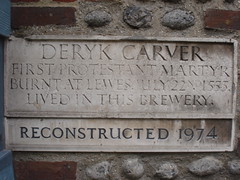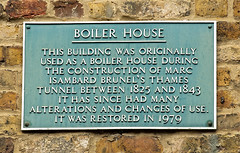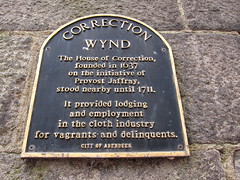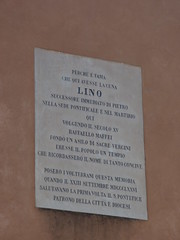Documenting the historical links between people and places as recorded by commemorative plaques
contribute
- You are all part of our mission to find all of the plaques in the world!
- Spotted one? Anyone can help us and add a plaque
- Take a photo. Add it to Wikimedia Commons or Flickr and link it to our record
- Spot an innaccuracy. Tell us.
Open Data
news
Follow us on Twitter and Facebook for updates.
Plaque Of The Day
Jez says, "During the Civil War, Robert Greville, 2nd Baron Brooke commanded Parliament forces in Warwickshire and Staffordshire. Many consider Greville to be the first victim of sniper fire."
Place Of The Day
Norwich, United Kingdom
Norwich has a long history. It has been a city since 1094. From the Middle Ages until the Industrial Revolution, Norwich was the largest city in England after London and one of the most important. This is refelected in its plaques.
Most-viewed plaques
In the last 11 years, between 20 May 2009 to 6 Jan 2021, Open Plaques had 4,530,517 page views from 1,234,480 users. Some were triggered by internet memes such as Steve Ullathorne's 2012 image of a George Orwell plaque with a CCTV camera next to it. Others, such as those for Alan Turing, were probably triggered by an anniversary and campaign for recognition.
- George Orwell 1903-1950 novelist & political essayist lived here (19526 page views)
- Jacob von Hogflume 1864-1909 Inventor of time travel. lived here in 2189 (15077 page views)
- George Orwell 1903-1950 novelist and political essayist lived here (6390 page views)
- Jimi Hendrix 1942-1970 guitarist and songwriter lived here 1968-1969 (5714 page views)
- Alan Turing 1912-1954 founder of computer science and cryptographer, whose work was key to breaking the wartime Enigma codes, lived and died here. (4085 page views)
- Sir Arthur Conan Doyle 1859-1930 creator of Sherlock Holmes lived here 1891-1894 (3846 page views)
- Alan Turing 1912-1954 code breaker lived here from 1945-1947 (3679 page views)
- This building housed the offices of Charles Dickens' magazine 'All The Year Round' and his private apartments 1859-1870 (3339 page views)
- Dame Agatha Christie 1890-1976 detective novelist and playwright lived here 1934-1941 (3027 page views)
- The Peterloo Massacre. On 16th August 1819, a peaceful rally of 60,000 pro-democracy reformers, men, women and children was attacked by armed cavalry resulting in 15 deaths and over 600 injuries. (3006 page views)
recently photographed plaques

Deryk Carver first Protestant martyr burnt at Lewes July 22nd 1555 lived in this brewery.
The Black Lion Pub, 14 Black Lion Street, Brighton, United Kingdom
Subjects
Boiler House This building was originally used as a boiler house during the construction of Marc Isambard Brunel's Thames Tunnel between 1825 and 1843 It has since had many alternations and changes of use. It was restored in 1979
Tunnel Road, London, United Kingdom
Subjects
Las aguas nos arrebataron vidas, arrasaron hogares, nos dejaron lágrimas y luto, pero quedó intacto el afán de superación de los habitantes de Santa Cruz. De la desesperación se alimentó la esperanza y la solidaridad de un pueblo, que supo sobreponerse a la desgracia y trabajar por la reconstrucción.
Avenida Francisco la Roche, 47, Santa Cruz de Tenerife, Spain
Correction Wynd. The House of Correction, founded in 1637 on the initiative of Provost Jaffray, stood nearby until 1711. It provided lodging and employment in the cloth industry for vagrants and delinquents.
Back Wynd, off Union Street, Aberdeen, United Kingdom
Subjects
Perche e fama che qui avesse la cuna Lino successore immediato di pietro nella sede pontificale e nel martirio qui volgendo il secolo XV Raffaello Maffei Fondo un asilo di sacre vergini eresse il popolo un tempio che ricordassero il nome di tanto concive. Posero I Volterrani questa memoria quando il XXIII Settembre MDCCCLXXVI Salutavano la prima volta il S. Pontefice Patrono della City e Diocesi.
English translation: Why it is fame that here had the cuna Lino immediate successor of Peter in the pontifical seat and martyrdom here turning the XV century Raphael Maffei Fund a kindergarten of sacred virgins erected the people a temple to remember the name of so much concive. They put this memory on the XXIII September MDCCCLXXVI greeted the Holy Pontiff Patron of the City and Diocese for the first time. [AWS Translate]
Chiesa di San Lino - Via San Lino, Volterra, Italy
Subjects
Original Smithsonian Institution Building erected 1847-57. Designed by James Renwick Jr. in Twelfth Century Romanesque style for the first offices, research laboratories, exhibits, collections and lectures of the Smithsonian Institution, dedicated to the increase and diffusion of knowledge among men.
The National Mall, Washington, DC, United States
Tällä paikalla olleessa talossa syntyi runoilija ja tiedemies Johan Jacob Nervander helmikuun 23 päivänä 1805
English translation: In the house on this site, the poet and scientist Johan Jacob Nervander was born on 23 February 1805 [AWS Translate]
Koulukatu 7, Uusikaupunki, Finland
"The Diamond Jubilee Wood" This plaque was unveiled by Mr Francis Dymoke a descendant of champion John Dymoke rector of this parish in 1822, on Sunday 2nd June 2013, the 60th Anniversary of the Coronation of our Queen.
, Wood Enderby, United Kingdom
Hier wohnte Mathilde Adele Bier geb. Grünebaum Jg. 1884 deportiert 1942 Zamosc ermordet
English translation: Here lived Mathilde Adele beer née Grünebaum Jg. 1884 deported 1942 Zamosc murdered [AWS Translate]
Gerberstraße 9, Witten, Germany
The Mining Institute. Opened 1913. Closed as a college 1987.
Queen Street, Chasetown, United Kingdom
Bragdy Felin-foel Felinfoel Brewery Adeiladwyd/ Built 1878 Y bragdy cyntaf ym Mhrydain Fawr i osod cwrw mewn caniau ym 1936, a'r ail yn y byd The first brewery in Great Britain to commercially can beer in 1936, and the second in the world
Farmers Row, Llanelli, United Kingdom
Subjects
Texas Historical Marker #10473
Bloys Camp Meeting. Held each year since 1890. Founded by Rev. W. B. Bloys, a Presbyterian. His camp pulpit was an Arbuckle Coffee crate. First campers, 48 people from remote ranches and towns, slept in tents, wagons. Family groups had chuck-box meals, sharing with guests. Some 1,500 attend mid-August meetings today. Still nothing is ever sold in camp. Baptists, Disciples of Christ, Methodists and Presbyterians incorporated the Cowboys' Camp Meeting in 1902. Site, Skillman Grove, has been a camp ground since the 1850s. Elevation is about 6,000 feet. #10473
TX-166, Fort Davis, TX, United States













